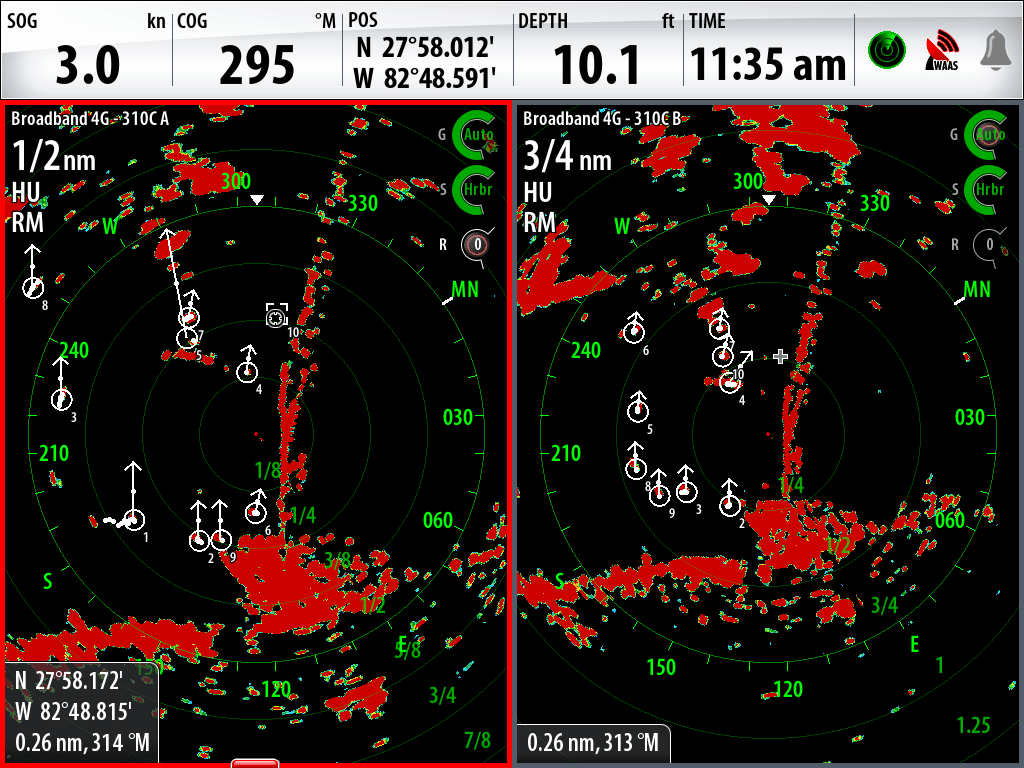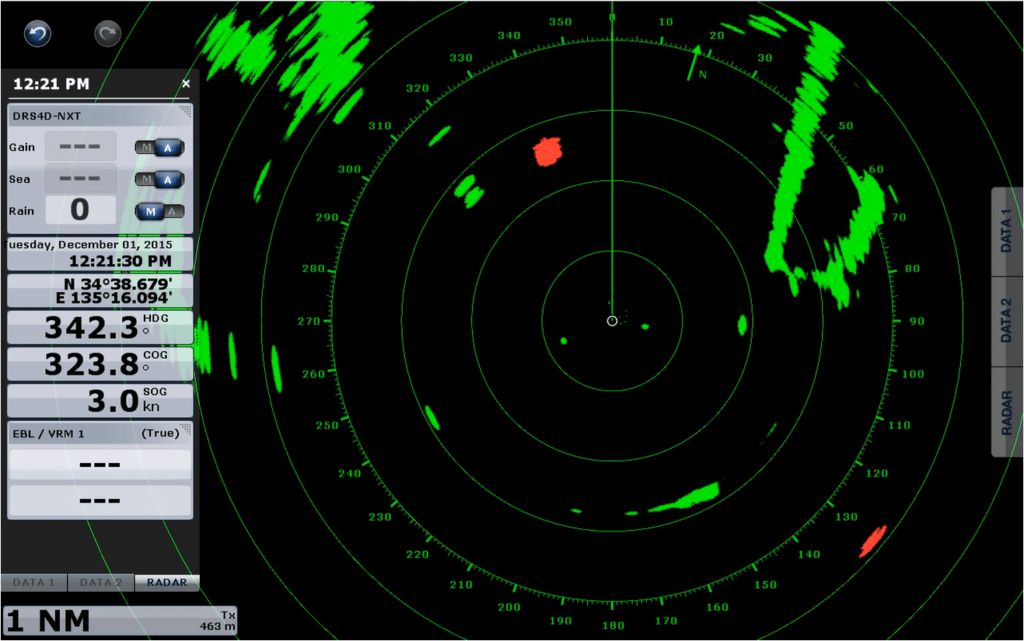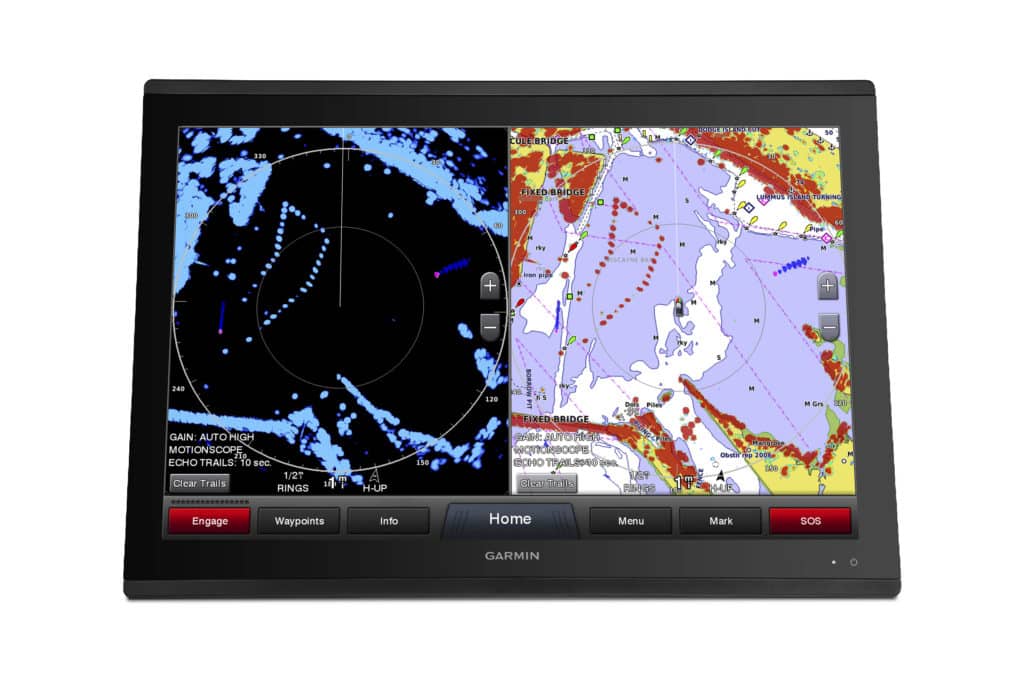
The mid-November night was like any other on Puget Sound: clear star shots overhead, periodically obscured by misty rains. Two friends and I were delivering a 45-footer from Anacortes to Seattle, and while our passage across the Strait of Juan de Fuca was quiet and the tide cooperative, Puget Sound was a different story. Our ebb-tide magic-carpet ride continued, but we quickly discovered that we were sharing it with heavy metal ranging from container ships and ferries to low-slung tugboats. Our boat was equipped with an AIS receiver but not radar, so while we were aware of the commercial traffic, we were electronically blind to non-AIS-equipped vessels.
A sailboat crew making the same transit today could cruise with much less stress if the boat were equipped with the latest generation of solid-state radar, which takes advantage of big advances in materials, performance, and in some cases even Doppler processing, which helps to differentiate moving objects and weather from stationary vessels and landmasses. Here’s a roundup of the latest developments in recreational-marine radar and the benefits they provide.
B&G’s Different Tack
Electronics manufacturer Navico, whose brands include B&G and its line of sailing instruments, turned heads in late 2011 when it released its solid-state broadband 4G radar system, which is unique in that it uses frequency-modulated continuous-wave technology, rather than pulse-compression technology, to transmit and receive. An FMCW radar transmits signals at the same time that it’s receiving the returning echoes, explains Mark Harnett, B&G’s recreational-radar product manager. The radome — the round canister you see mounted on the mast or a stern pole — has two independent antennas, allowing it to continuously transmit while simultaneously receiving echo returns. Conversely, both old-school magnetron and today’s latest generation of solid-state pulse-compression radars use a single antenna that splits its duty cycle between transmitting and receiving modes.
Likewise, broadband 4G has dual processors, which allows the radar to simultaneously generate imagery from two different range settings (for example, 3 nautical miles and 36 nautical miles), which can be displayed on a single split-screen multifunction display or on multiple displays operating in single-screen mode.
“It’s like having two radars in one,” says Harnett. (Garmin’s Fantom and Furuno’s DRS4D-NXT radars also feature dual-range functionality, but use different technology to do so. More on that in a minute.)
As with some other radar systems, broadband 4G uses beam-sharpening technology that helps shorter antennas realize better performance and target separation. Target separation is an important feature because it lets you discern, say, a tug towing a barge, or two small vessels that might have appeared as a single target on an older radar.
Broadband 4G also features B&G’s proprietary Directional Sensitivity Time Control, which allows the radar to automatically adjust its gain. Harnett says Directional STC uses an algorithm to increase sensitivity when sailing downwind — when there’s generally less sea clutter — and to reduce sensitivity when sailing uphill; it continually measures the amount of clutter and adjusts its gain on a directional basis. In practical terms, this means you’ll get the clearest target definition that the sea state allows.
Additionally, broadband 4G features a mini automatic radar plotting aid (MARPA) that allows the radar to track up to 10 user-specified targets at each range setting (meaning that the radar can track up to 20 MARPA targets in dual mode), provided that the radar is networked with a heading sensor. Broadband 4G radars are compatible with B&G’s line of Zeus multifunction displays.
Lastly, while it’s possible to add Doppler functionality using FMCW technology, it’s unclear if B&G will release a Doppler update for the current generation of radar or hold off and include it with its fifth iteration of solid-state radar.

Furuno Debuts Doppler
If you’ve heard the high-pitched wail of an approaching ambulance’s siren, followed by its lower-frequency cry as the emergency vehicle speeds away, you’ve experienced the Doppler effect. In essence, as the vehicle approaches your position, each successive sound wave physically takes less time to reach your ears, causing the waves to bunch up and create a higher-pitched sound; as the ambulance recedes and each successive wave takes longer to reach your position, the waves spread out and yield a lower-pitched sound.
A critical key to perceiving the Doppler effect, of course, is that the siren’s frequency remains constant, as oscillating frequencies would make it impossible to determine if the ambulance were approaching or moving past. In terms of radar, the Doppler effect can be used to determine a target’s motion.
Traditional recreational-marine radars use cavity magnetrons to generate radar microwave pulses, but the pulse’s frequency varies over time and is affected by temperature changes and unit-to-unit manufacturing tolerances, making it historically impossible to employ Doppler technology, says Eric Kunz, Furuno’s senior product manager. More advanced and sophisticated solid-state amplifiers, which can transmit compressed high-intensity radar pulses (commonly known as “chirp” signals) at highly predictable frequencies, have dropped substantially in price, allowing Furuno and other manufacturers to introduce them into their product line and bring Doppler signal processing aboard as well. Furuno includes this technology in its new 25-watt DRS4D-NXT.
Unlike traditional radars, Doppler radars can instantly determine whether an object is stationary or in motion, and if an object is moving, they can calculate its course and speed. Targets at rest appear as traditional radar returns, but Furuno’s proprietary Target Analyzer feature, which can be turned on or off, considers anything that’s moving faster than 3 knots to be a target; approaching targets are painted red, while ebbing or nonthreatening targets are colored green.
Traditional radar, explains Kunz, transmits a pulse that travels at the speed of light in a specific direction. The radar knows what time the pulse went out and what time it came back, and it uses that information to paint the radar picture. He adds that Furuno has long built its own proprietary microwave integrated circuits, which are integral to how all Furuno radars receive and process their radar imagery. “Doppler takes this to the next level, as it knows the pulse’s exact frequency,” he says. “It’s like ringing a bell versus sending an exact blip frequency. We can take the compressed pulse and unpack it.”
DRS4D-NXT radars feature dual-range functionality and an automatic radar plotting aid, which automatically acquires and tracks up to 40 different targets (60 additional targets can be manually entered); however, a separate networked heading sensor is required to enable this feature. The DRS4D-NXT radars are compatible with Furuno’s NavNet TZtouch and TZtouch2 multifunction displays.

Garmin’s Evolving Technology
When it comes to fitting radar onto sailboats, radomes are far more practical than open-array systems, as radomes use less power, take up less space and, most importantly, won’t accidentally tangle sheets or sails in the uncovered, spinning antenna. From this perspective, Garmin’s 4-kilowatt GMR 24 xHD is currently the company’s top-of-the-line sailboat product. While the GMR 24 xHD’s imagery is sharp, it uses a cavity magnetron, and not the newer solid-state componentry, to generate radar microwave pulses.
Garmin’s state-of-the-art technology is presently found in its recently released dual-range GMR Fantom 6 and GMR Fantom 4 radars, which respectively sport 6-foot and 4-foot open-array antennas, and which use solid-state power amplifiers to transmit X-band chirps at precisely controlled frequencies. These solid-state amplifiers enable Garmin’s proprietary MotionScope technology to harness Doppler signal processing.
Ryan Schmitz, Garmin’s project manager and design-engineering team leader for radar, explains that pulse compression gives Fantom radars high on-screen range resolution, which means they present the same (or better) radar imagery while using considerably less peak power. Schmitz adds that a similarly sized magnetron radar might use 4 or 6 kilowatts, while Fantom uses just 40 watts.
Fantom radars display target movements using distinct colors, which is similar to Furuno’s approach.
Garmin debuted Fantom in early 2016, and one has to imagine that the company will bring its powerful new technology into its radome series in the near future, given that it’s now less expensive to build recreational-marine radars using solid-state componentry than it is to use magnetrons.
Raymarine’s Next Step
Much like Furuno’s DRS4D-NXT and Garmin’s Fantom radars, Raymarine’s new 20-watt radome-enclosed and chirp-enabled Quantum radars use solid-state power amplifiers rather than cavity magnetrons to generate microwave pulses. Additionally, Quantum radars use compatible supporting components, which reduces noise in adjacent electronic circuits. Jim McGowan, Raymarine’s Americas marketing manager, says these components allow Quantum to use higher frequencies and sustain operation at higher temperatures, with less degradation or long-term performance loss than the older generation componentry it replaces. Moreover, the lower noise signature at higher frequencies allows Quantum’s interference-rejection algorithms to focus on eliminating external noise rather than combating internal electrical interference.
“Chirping has been around forever, but it’s new to recreational radars,” says Adam Murphy, Raymarine’s radar products manager, who describes the benefits of chirp radar as similar to chirp-enabled sonar. Raymarine and other manufacturers released this product a couple of years ago in depth-sounding and fish-finding products, and it allows users to create detailed underwater views.
“You can shoot a shorter radar microwave pulse, but you can shape that pulse so that it can still mark things at a very close range,” says Murphy. “Since there’s shape to that pulse, you can match it exactly as it returns from reflections of targets.”
The ability to shape and match radar microwave pulses allows chirp-enabled radars to better depict and display targets that are closely juxtaposed on a fore-aft range scale, such as channel-marker buoys, when compared to what was possible using fixed-frequency magnetron radars. At work on the water, the pulse’s shape allows the radar to receive two separate radar signatures, rather than one return that overlaps the two targets.
McGowan demonstrated Quantum’s advanced target-separation capabilities at the 2016 Miami International Boat Show when we drove a Quantum-equipped boat under the Rickenbacker Causeway and easily counted individual causeway pilings on the radar display. Additionally, Quantum offers a range of one-sixteenth to 24 nautical miles, as well as the ability to wirelessly share radar imagery with a compatible Raymarine multifunction display via Wi-Fi. This reduces weight aloft since only a power cable needs to run to the radome, rather than a heavier, bulkier data and power cable. (Users also have the option to use a proprietary RayNet Ethernet cable to connect their radar with their display.)
While Quantum doesn’t currently support Doppler imaging, McGowan and Murphy note that Doppler is just a software process within a chirp-enabled radar. “There’s nothing in the hardware that’s stopping us from working on a Doppler software update,” says Murphy. While assumptions can be slippery slopes, odds are excellent that Raymarine will release a Quantum Doppler software update in the near future.
David Schmidt is CW’s electronics editor.








